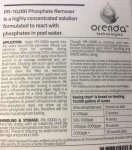Hello all,
Long time lurker, first time post.
I am a pool professional of 20 years, having owned and operated a pool service and construction business as my primary source of income and career choice by default.
This forum has been a great resource, despite attending countless training seminars over the years. It provides pool operators of all shapes and sizes from all over the country a glimpse into real-world pool problems and gives anyone who wants to learn about pool care the information they need to take matters into their own hands. As one who will unashamedly open a manual for a piece of equipment I'm repairing, call tech support to be sure I do the right thing, or consult a guide to pool chemistry now and again, I embrace the fact that we are all constantly learning and thats what makes the good, great. So much thanks and respect to those who make this forum happen and to those who contribute to the common goal of clean and safe swimming pools.
So.
Phosphates.
I have been aware of the continuing debate over phosphates and do realize that most pool professionals I have seen post online, take the stance that phosphates are of no concern and can be dealt with through traditional chemical methods. However, in my many years of experience taking care of pools and keeping customers happy, I have routinely turned to phosphate treatments to help clear up countless instances of high orthophosphate pollution, with dramatically positive results. The truth is, to me anyway, that these products really work. Be it the stellar clarifying / floccing effects they provide, or the rapid improvement of a pool's chemical performance (in most cases, by the weekend), something about them just invariably works and I've been able to count on their predictable performance in solving problems quickly time and time again.
That is not to try and debunk the theory that phosphates (really orthophosphates) are not of concern to pool maintenance, but to try and learn why there is such a debate over their impact and the effectiveness of available treatments. Particularly given the cost of the chlorine required in lieu of phosphate treatments and speed at which these phosphate removers work. What are some of your takes and experiences with respect to this debate?
Also, regarding salt chlorine generators: phosphates have been found to incapacitate salt cells. Shouldn't this be of concern when testing high orthophosphates?
 tldr:
tldr:
Why the debate over phosphates, given the fast and predictable effectiveness of available phosphate treatments? What have your experiences been when using more traditional methods of clearing up algae blooms or difficulties with maintaining Cl residual? What about their effects on salt chlorine generators?
Apologies for the long post.
I hope I didn't miss another thread addressing this.
Lou
Long time lurker, first time post.
I am a pool professional of 20 years, having owned and operated a pool service and construction business as my primary source of income and career choice by default.
This forum has been a great resource, despite attending countless training seminars over the years. It provides pool operators of all shapes and sizes from all over the country a glimpse into real-world pool problems and gives anyone who wants to learn about pool care the information they need to take matters into their own hands. As one who will unashamedly open a manual for a piece of equipment I'm repairing, call tech support to be sure I do the right thing, or consult a guide to pool chemistry now and again, I embrace the fact that we are all constantly learning and thats what makes the good, great. So much thanks and respect to those who make this forum happen and to those who contribute to the common goal of clean and safe swimming pools.
So.
Phosphates.
I have been aware of the continuing debate over phosphates and do realize that most pool professionals I have seen post online, take the stance that phosphates are of no concern and can be dealt with through traditional chemical methods. However, in my many years of experience taking care of pools and keeping customers happy, I have routinely turned to phosphate treatments to help clear up countless instances of high orthophosphate pollution, with dramatically positive results. The truth is, to me anyway, that these products really work. Be it the stellar clarifying / floccing effects they provide, or the rapid improvement of a pool's chemical performance (in most cases, by the weekend), something about them just invariably works and I've been able to count on their predictable performance in solving problems quickly time and time again.
That is not to try and debunk the theory that phosphates (really orthophosphates) are not of concern to pool maintenance, but to try and learn why there is such a debate over their impact and the effectiveness of available treatments. Particularly given the cost of the chlorine required in lieu of phosphate treatments and speed at which these phosphate removers work. What are some of your takes and experiences with respect to this debate?
Also, regarding salt chlorine generators: phosphates have been found to incapacitate salt cells. Shouldn't this be of concern when testing high orthophosphates?
 tldr:
tldr:Why the debate over phosphates, given the fast and predictable effectiveness of available phosphate treatments? What have your experiences been when using more traditional methods of clearing up algae blooms or difficulties with maintaining Cl residual? What about their effects on salt chlorine generators?
Apologies for the long post.
I hope I didn't miss another thread addressing this.
Lou


 )
)


